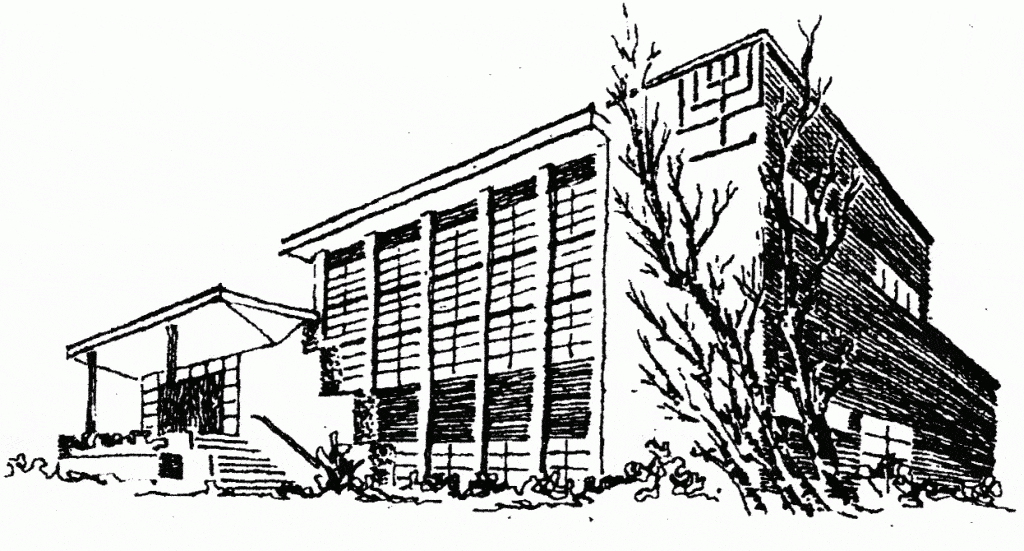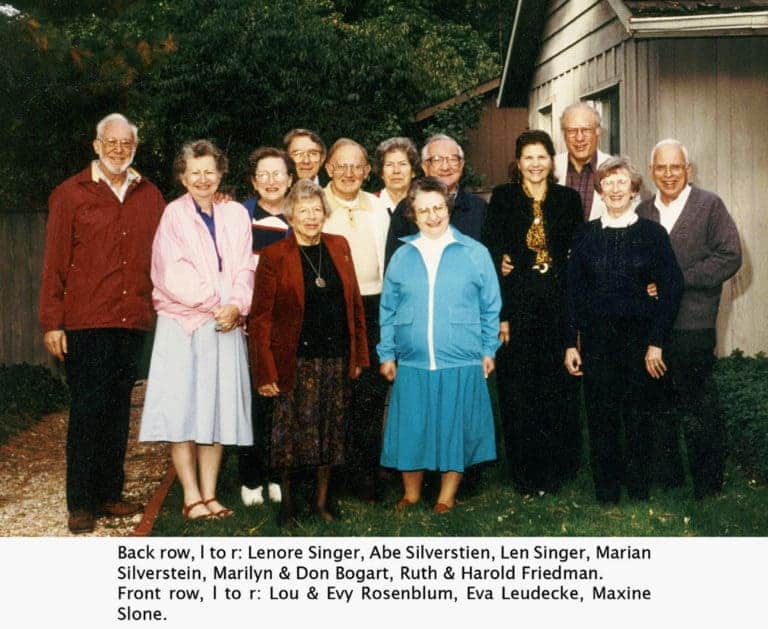Sixty-five years ago, a small group of individuals had the courage and determination to create a new Jewish community on Cleveland’s West Side. Most of them were scientists working at the research center that has become the National Aeronautics and Space Administration, or NASA, an hour’s drive from the established hub of Cleveland’s Jewish community on the East Side.
Abe Silverstein, then associate director of the center, persuaded the Jews who worked there that they needed a temple to serve this West Side Jewish community.

“Abe presented his vision and plan for a wider, more active Jewish community. Our assistance was solicited, and, with the high regard we held for him, a request was as good as an assignment.”
The congregation’s first Rosh Hashanah service was held September 27, 1954, at the First Universalist Church in North Olmsted, Ohio. For the next three years, services were held either at the Universalist Church or the North Olmsted Community Club House. Following its merger with the West Side Jewish Center, on October 25, 1957, Beth Israel occupied the center’s newly completed building at 14308 Triskett Road and dedicated the structure May 11, 1958. The congregation still occupies the site today. For its first seven years, Beth Israel was served by a succession of six student rabbis from Hebrew Union College in Cincinnati. One of these, Daniel Litt, became its first full-time rabbi, serving from 1961 to 1965. From 1965 to 1994, five rabbis have occupied Beth Israel’s pulpit. The religious school opened in January 1955, in rooms rented at Gilles-Sweet school in Fairview Park, Ohio. The school, now headed by a professional Congregational Educator and staffed by volunteer teachers, covers preschool through grade 12, and enrolls over 100 students. In 1965 and 1985, the Cleveland Foundation awarded the congregation library grants to enlarge its collection. The library and its volunteer staff have provided services for the congregation as well as for schools, colleges, and churches in western Cuyahoga County.
“We moved to Cleveland in 1959 with four children ages 5 to 12, but with few local friends or contacts. Beth Israel quickly became ‘family’ for us!…Beyond providing friendships and co-workers, Beth Israel helped us toward the feeling that we were part of an institution dedicated to Jewish perpetuation.”
It was not until 1910 that a second West Side Jewish Center was organized, as B’nai Israel, by ten Orthodox families, who rented a hall at 2525 Lorain Road. As the West Side Jewish Center congregation grew to over 120 families in the 1920s, a succession of structures was acquired: a house at 1794 W. 30th St. (1912); the Free Methodist Church building at the corner of West 25th St. and Bridge Ave. (1918); and a newly constructed building at 1791 W. 57th St (1926). And, for burial needs, a portion of the Ridge Road Cemetery, 3824 Ridge Road, was purchased from Taylor Road Synagogue in 1922. By 1919 the congregation had affiliated with the United Synagogue of America, the national umbrella organization for Conservative Judaism, and hired its first rabbi, Harry Cohen, a Conservative. From 1920 to 1937, a succession of eight rabbis served the center. The Great Depression led to a decline in its membership and loss of its building in 1937. A small house was purchased at 4101 John Ave. three years later. During the period 1939 to 1957, membership averaged 55 and rabbis served for only six of the eighteen years. In 1955, with more hope than financing, construction was begun on a two-story building on Triskett Road. The building was completed and occupied in early 1957. A few months later, with a lien on the building and its resources exhausted, the center merged with Beth Israel. This merger allowed Beth Israel to assume ownership of the building, and brought the one-time Orthodox, then Conservative, congregation into the Reform movement.
How did a Reform congregation come to be affiliated with an Orthodox synagogue? The first Jewish presence on the West Side was Oheb Zedek Hungarian Congregation, an Orthodox synagogue established about 1883 at the southwest corner of Lorain Avenue and Root (West 47th) Street. That congregation was led by Rabbi David Feuerlicht, who also instructed its 34 religious school pupils. However. there is no record of it after 1889.
It was not until 1910 that a second West Side Jewish Center was organized, as B’nai Israel, by ten Orthodox families, who rented a hall at 2525 Lorain Road. As the West Side Jewish Center congregation grew to over 120 families in the 1920s, a succession of structures was acquired: a house at 1794 W. 30th St. (1912); the Free Methodist Church building at the corner of West 25th St. and Bridge Ave. (1918); and a newly constructed building at 1791 W. 57th St (1926). And, for burial needs, a portion of the Ridge Road Cemetery, 3824 Ridge Road, was purchased from Taylor Road Synagogue in 1922. By 1919 the congregation had affiliated with the United Synagogue of America, the national umbrella organization for Conservative Judaism, and hired its first rabbi, Harry Cohen, a Conservative. From 1920 to 1937, a succession of eight rabbis served the center. The Great Depression led to a decline in its membership and loss of its building in 1937. A small house was purchased at 4101 John Ave. three years later. During the period 1939 to 1957, membership averaged 55 and rabbis served for only six of the eighteen years. In 1955, with more hope than financing, construction was begun on a two-story building on Triskett Road. The building was completed and occupied in early 1957. A few months later, with a lien on the building and its resources exhausted, the center merged with Beth Israel. This merger allowed Beth Israel to assume ownership of the building, and brought the one-time Orthodox, then Conservative, congregation into the Reform movement.
In 1972, Rabbi Sally Priesand, a graduate of Beth Israel’s religious school, became the first woman ordained to the rabbinate in the U.S.
Today, Beth Israel draws its members from a broad geographic area of Cleveland’s West Side and its western suburbs: from Oberlin and Avon in Lorain County to Medina County on the south. The temple expanded its facilities in 1965 with the construction of a new eight-room, two-story wing.
“Among the many things I learned growing up at Beth Israel, two are foremost in my mind: what it means to be a temple family and the importance of tikkun olam (repairing the world). I have tried to incorporate both of these in my rabbinate, and I shall always be grateful to the members of Beth Israel for setting such a wonderful example.”
In 1992, a group of “old-timers” met to reminisce about the founding of Beth Israel – The West Temple

THE CLEVELAND COUNCIL ON SOVIET ANTI-SEMITISM
THE CLEVELAND COUNCIL ON SOVIET ANTI-SEMITISM, a grassroots organization, brought attention to the plight of Soviet Jews from 1963 until 1983. It began as a study group led by three of the founding members of Beth Israel – The West Temple in 1963: Louis Rosenblum, Herbert Caron, and Abe Silverstein. Though the council included prominent rabbis, pastors, priests, and city officials, many initial council members were fellow congregants. As the first such group in the world, this organization spawned other local councils and a national organization. Between 1964-69, the Cleveland council developed educational tools, such as organizational handbooks for other communities, the newsletter Spotlight, and media presentations. They also devised protest strategies that became integral to the movement to free Soviet Jewry. One of the council’s most successful activities was the People-to-People program of the late 1960s, which represented 50,000 members.
Although not officially sponsored by Beth Israel – The West Temple, the temple provided office space to the council from 1964-78, and the council periodically reported to the congregation’s Social Action Committee. Although the Cleveland council was still active in 1985, by the late 1970s the Jewish Community Federation had taken over the major local organizing effort for Soviet Jewry. By 1993, the Cleveland Council on Soviet Anti-Semitism no longer needed to exist, as it had accomplished its mission, and the Soviet Union had also ceased to exist.
“Though as a kid I’d get annoyed that we couldn’t drag my dad away from an impassioned discussion with Lou Rosenblum, Herb Caron, Mort Epstein, Dan Litt, or others about Israel or other controversial topics after Friday night services…their passion made an impression on me–the roots of my values and choice of career in working toward social and economic justice were in Beth Israel and my parents…” —
